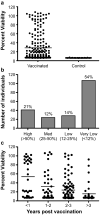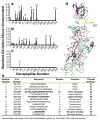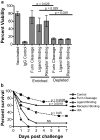Select human anthrax protective antigen epitope-specific antibodies provide protection from lethal toxin challenge
- PMID: 20533877
- PMCID: PMC2891133
- DOI: 10.1086/653495
Select human anthrax protective antigen epitope-specific antibodies provide protection from lethal toxin challenge
Abstract
Bacillus anthracis remains a serious bioterrorism concern, and the currently licensed vaccine remains an incomplete solution for population protection from inhalation anthrax and has been associated with concerns regarding efficacy and safety. Thus, understanding how to generate long-lasting protective immunity with reduced immunizations or provide protection through postexposure immunotherapeutics are long-sought goals. Through evaluation of a large military cohort, we characterized the levels of antibodies against protective antigen and found that over half of anthrax vaccinees had low serum levels of in vitro toxin neutralization capacity. Using solid-phase epitope mapping and confirmatory assays, we identified several neutralization-associated humoral epitopes and demonstrated that select antipeptide responses mediated protection in vitro. Finally, passively transferred antibodies specific for select epitopes provided protection in an in vivo lethal toxin mouse model. Identification of these antigenic regions has important implications for vaccine design and the development of directed immunotherapeutics.
Conflict of interest statement
The authors have no commercial or other associations that might pose a conflict of interest.
Figures





Similar articles
-
Sequential B-cell epitopes of Bacillus anthracis lethal factor bind lethal toxin-neutralizing antibodies.Infect Immun. 2009 Jan;77(1):162-9. doi: 10.1128/IAI.00788-08. Epub 2008 Nov 3. Infect Immun. 2009. PMID: 18981257 Free PMC article.
-
In vitro and in vivo characterization of anthrax anti-protective antigen and anti-lethal factor monoclonal antibodies after passive transfer in a mouse lethal toxin challenge model to define correlates of immunity.Infect Immun. 2007 Nov;75(11):5443-52. doi: 10.1128/IAI.00529-07. Epub 2007 Aug 20. Infect Immun. 2007. PMID: 17709410 Free PMC article.
-
Human monoclonal antibodies against anthrax lethal factor and protective antigen act independently to protect against Bacillus anthracis infection and enhance endogenous immunity to anthrax.Infect Immun. 2007 Nov;75(11):5425-33. doi: 10.1128/IAI.00261-07. Epub 2007 Jul 23. Infect Immun. 2007. PMID: 17646360 Free PMC article.
-
Combinations of monoclonal antibodies to anthrax toxin manifest new properties in neutralization assays.Infect Immun. 2013 Jun;81(6):1880-8. doi: 10.1128/IAI.01328-12. Epub 2013 Mar 18. Infect Immun. 2013. PMID: 23509144 Free PMC article.
-
Stochastic humoral immunity to Bacillus anthracis protective antigen: identification of anti-peptide IgG correlating with seroconversion to Lethal Toxin neutralization.Vaccine. 2013 Apr 3;31(14):1856-63. doi: 10.1016/j.vaccine.2013.01.040. Epub 2013 Feb 13. Vaccine. 2013. PMID: 23415781 Free PMC article.
Cited by
-
Impact of HLA Polymorphism on the Immune Response to Bacillus Anthracis Protective Antigen in Vaccination versus Natural Infection.Vaccines (Basel). 2022 Sep 20;10(10):1571. doi: 10.3390/vaccines10101571. Vaccines (Basel). 2022. PMID: 36298436 Free PMC article.
-
Characterization of the adaptive immune response of donors receiving live anthrax vaccine.PLoS One. 2021 Dec 20;16(12):e0260202. doi: 10.1371/journal.pone.0260202. eCollection 2021. PLoS One. 2021. PMID: 34928976 Free PMC article.
-
Protective antigen-specific memory B cells persist years after anthrax vaccination and correlate with humoral immunity.Toxins (Basel). 2014 Aug 13;6(8):2424-31. doi: 10.3390/toxins6082424. Toxins (Basel). 2014. PMID: 25123559 Free PMC article.
-
The role of HLA-DR-DQ haplotypes in variable antibody responses to anthrax vaccine adsorbed.Genes Immun. 2011 Sep;12(6):457-65. doi: 10.1038/gene.2011.15. Epub 2011 Mar 3. Genes Immun. 2011. PMID: 21368772 Free PMC article. Clinical Trial.
-
Exploiting human memory B cell heterogeneity for improved vaccine efficacy.Front Immunol. 2011 Dec 15;2:77. doi: 10.3389/fimmu.2011.00077. eCollection 2011. Front Immunol. 2011. PMID: 22566866 Free PMC article.
References
Publication types
MeSH terms
Substances
Grants and funding
LinkOut - more resources
Full Text Sources
Other Literature Sources
Medical
Molecular Biology Databases

